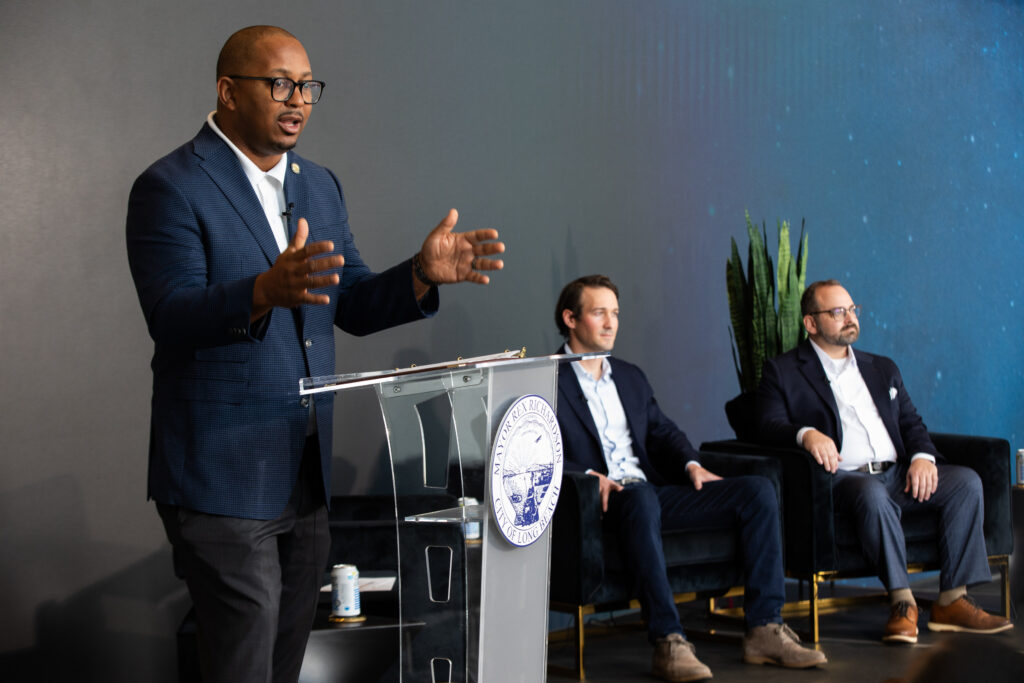Citing a favorable market and proximity to Space Force military bases, aerospace company True Anomaly announced Wednesday it will open a 90,000-square-foot plant at the Long Beach Airport to build its reconnaissance satellites.
At a press conference, Long Beach Mayor Rex Richardson commended the company executives who made the announcement about a year after the mayor and his team met with True Anomaly to pitch them on the city.
“We spent a lot of time just talking about the advantages and benefits of Long Beach,” Richardson recalled. “For example, today we’re 75 degrees, and what’s the temperature out in Denver? Seven? That’s an advantage.”
Founded in 2022, the Colorado startup has earned several multi-million dollar contracts in the defense sector, focused on developing spacecraft and piloting software for the military.
This is the company’s first facility in California; it currently is headquartered in Centennial, Colo. with another location in Colorado Springs. Between its three locations, the company wants to double its current 150 employees — 20 are already in Los Angeles County — in the next 18 months.
“We’re going to take our shot at companies like True Anomaly, to make sure that they can come here and bring 100 jobs that are going to pay a living wage,” Richardson said.
The company currently has thirteen local job openings, mostly for engineers.
Chief Financial Officer Mark Seidel said they hope to open the facility at airport-adjacent Douglas Park by next month, though construction will take up to a year to finish. Contracted by the federal Department of Defense, they are also investing in a second location locally for classified projects.

Most of the factory — about 70,000 square feet — will be open floor space to develop their brand of satellite, called Jackal. These satellites, CEO Even Rogers explained, are meant for reconnaissance, to protect U.S. spacecraft by watching and studying foreign objects that enter nearby orbit.
“This is what the Department of Defense calls space control,” Seidel said. “China and Russia are primary adversaries, and so we’re building what is needed to go deter the threat.”
Rogers compared it to a bodyguard service, using the example of colonial piracy necessitating the protection of maritime shipping lanes. When a threat pops up, a Jackal can quickly exit its orbital pattern, scout it out and return back.
“You’ve got to have someone come out there and control the shipping lanes, make sure piracy with other nefarious players, other countries, city-states, whatever, are not messing with your shipping,” Rogers explained. “So that’s what we’re doing.”
They also are developing an AI software called Mosaic, which operates the Jackal satellites.
The aerospace sector remains a major economic force in California: It ranks first in the nation for defense spending, and, with 771,000 jobs, it provides a nearly $190 billion economic impact statewide.
In Long Beach, eight new companies and 1,500 aerospace jobs — with another 2,000 expected by 2027 — have come about in the last two years. Today, Richardson estimates, more than seven million square feet of land citywide is used by the aerospace industry, either through manufacturing or research and development.
“We’ve been cited as one of the fastest-growing aerospace clusters in the entire United States,” Richardson said. “That’s why we call ourselves, ‘Space Beach.’”

True Anomaly’s four-acre campus is the latest of several aerospace, travel and satellite companies to park at 200-acre Douglas Park, much of which was left vacant by the Boeing Company’s production plant closure in 2015.
At the 2025 State of the City last month, Richardson announced Nikon’s plans to build a $100 million manufacturing plant in Long Beach; and last May, Hawthorne-based SpaceX renewed its lease in the Port of Long Beach for docking vessels and storage.
Other aerospace companies continue their work at the airport, including Rocket Lab — which celebrated its 60th launch on Tuesday — as well as Ampaire Inc., SpinLaunch, Vast and Relativity Space, which develops 3D-printed rockets.
The decision to move to Long Beach made sense, Rogers said, given its proximity to Space Systems Command in El Segundo and Vandenberg Space Force Base near Lompoc, Calif.
“Expanding to Southern California is a logical next step for True Anomaly,” Rogers said. “Long Beach has a deep history tied to aerospace and we’re currently at the forefront of historic innovations in the defense sector.”

